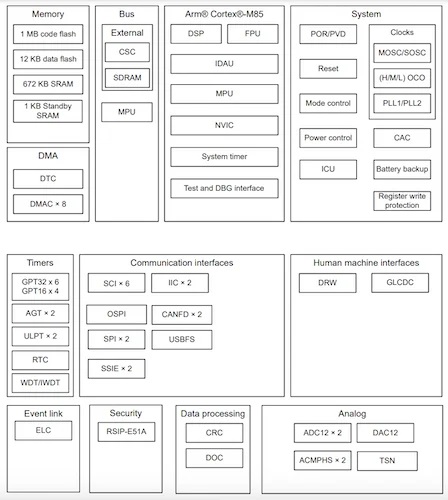Renesas Embeds Powerful Arm Cortex-M85 Into Entry-Level MCUs
Renesas' new 32-bit MCUs maintain the power of its RA8 series MCUs while streamlining their features, making them cost-effective for high-volume embedded applications.
This week, Renesas launched the RA8E1 and RA8E2 microcontroller families, two new product lines that embed the high-performance Arm Cortex-M85 core into entry-level MCUs.

RA8E1 and RA8E2.
As demand for real-time processing and secure, scalable solutions intensifies in IoT and industrial automation, the market has been demanding entry-level MCUs with capabilities typically reserved for higher-end devices. Read on to learn how the RA8E1 and RA8E2 families aim to meet these needs.
RA8E1: A 32-bit General-Purpose MCU
The RA8E1 microcontroller family (datasheet linked) is powered by a 360 MHz Arm Cortex-M85 core with Helium technology. Its architecture, based on the Armv8.1-M profile, supports the Arm Security Extension, allowing secure code execution with TrustZone, alongside an eight-region memory protection unit (MPU) for both secure and non-secure domains.
The MCU integrates 1 MB of code Flash memory with dual-bank operation and background swapping. Its 544 KB of SRAM includes 32 KB of tightly coupled memory (TCM), enabling low-latency accesses. With 12 KB of data Flash supporting 100,000 program/erase cycles, the microcontroller can handle frequent data logging and non-volatile storage needs.

Block diagram of the RA8E1.
Altogether, the MCU delivers high-performance capabilities, achieving up to 6.39 CoreMark/MHz. Renesas claims that this performance rating, combined with the MCU's floating-point unit (FPU) and M-profile Vector Extension (MVE) support with Helium, makes it well-suited for DSP and AI applications at the edge.
For power efficiency, the RA8E1 offers multiple low-power modes, an ultra-low-power timer, and a backup battery mode. Programmable voltage detection across three levels allows power stability monitoring. Integrated analog peripherals include dual 12-bit ADCs with up to 13 input channels and a 12-bit DAC.
RA8E2: A 32-bit Graphics MCU
The higher-performance RA8E2 microcontroller family (datasheet linked) employs a faster 480-MHz Arm Cortex-M85 core, also featuring Helium technology. Built on the Armv8.1-M architecture, it includes TrustZone and an advanced memory protection unit, providing eight secure and eight non-secure regions to safeguard operations. Its memory structure comprises 1 MB of dual-bank Flash and 672 KB of SRAM, with 32 KB as TCM.

Block diagram of the RA8E2.
The RA8E2's connectivity includes a 16-bit external memory interface, USB 2.0 Full-Speed, dual CAN-FD channels, and an Octal SPI interface for high-speed data transfer. It includes dual 12-bit ADCs and a 12-bit DAC, along with a high-speed comparator and temperature sensor.
The device also integrates a unique 2D drawing engine (DRW), which enhances its graphic processing capabilities directly on-chip. This engine supports various geometries and textures, including anti-aliasing and edge blurring, and operates at a rate of one pixel per clock. By rasterizing within bounding boxes, it optimizes graphics rendering for HMI displays, such as industrial or automotive control panels. Combined with the graphics LCD controller, the MCU enables efficient, high-resolution interface design without offloading to an external GPU, which is rare in embedded systems of this size and performance range.
Entry-Level MCUs With Advanced Features
The RA8E1 and RA8E2 microcontrollers mark a deliberate shift in microcontroller design, with Renesas pushing the boundaries of what entry-level MCUs can achieve in data-intensive and secure applications. With features typically found in high-end devices, these microcontrollers could enable more complex, real-time applications within cost-sensitive deployments. Such high-volume applications can include industrial and home automation, office equipment, healthcare, consumer products, and beyond.


.jpg)
